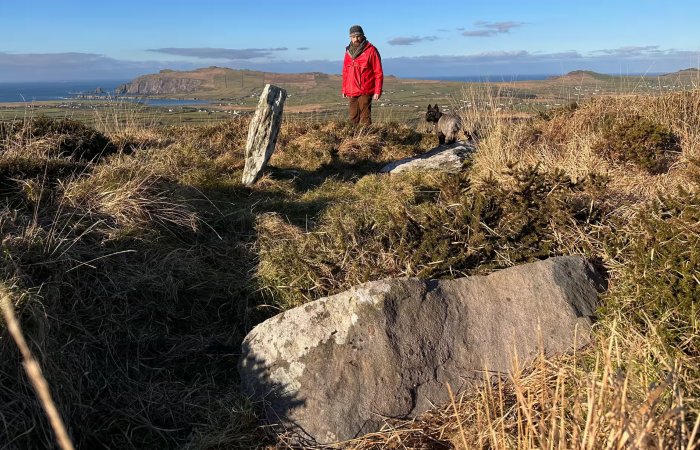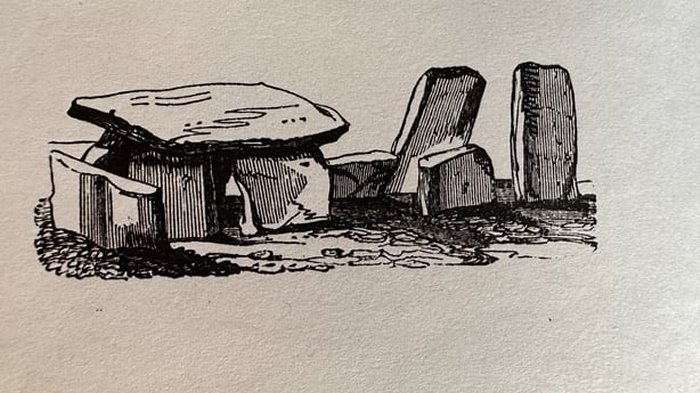Jan Bartek - AncientPages.com - Can a tomb that has stood in the same spot for thousands of years suddenly vanish? That is a question many pondered when trying to locate Altóir na Gréine, as the tomb is locally known.
Billy Mag Fhloinn with the remnants of the tomb. Credit: Seán Mac an tSíthigh/RTÉ News
The Altóir na Gréine, or sun altar, stood for about 4,000 years on a hill outside the village of Ballyferriter on the Dingle peninsula. In 1838, the Bronze Age tomb was thoroughly documented by Georgiana Chatterton (1806 - 1876), an English aristocrat, traveler, and author. Her sketch of the tomb showed what the structure looked like before vanishing in the mid-19th century. What had happened to Altóir na Gréine was not entirely clear. Many thought it had been dismantled. When antiquarian Richard Hitchcock visited the site in 1852, he said he had been broken up and carried away, most likely for building purposes, he thought.
The only known visual representation of Altóir na Gréine is this sketch made by Georgiana Chatterton in 1838.
The explanation would justify why most thought Altóir na Gréine was gone forever. However, some never gave up on the Bronze Age tomb. Some locals said the wedge tomb Altóir na Gréine was still hidden and not destroyed at all, but was there any truth to these stories or just wishful thinking?
In this case, those interested in ancient history and archaeology have reason to be excited about the recent rediscovery of the long-lost 4,000-year-old Irish tomb. While working on an archaeological mapping project, folklorist Billy Mag Fhloinn visited the site and filmed it. When he later converted the video into a 3D scan something curious caught his eye. Fhloinn noticed that a stone in the undergrowth resembled one from Lady Chatterton’s Victorian-era sketch. A closer examination confirmed his suspicions. This was indeed Altóir na Gréine!
The tomb's orientation, facing the setting sun to the west or southwest, reflects the cosmological beliefs of the Bronze Age people. Building tombs and altars with respect to the Sun's annual motions was common during the Bronze Age. Wedge Tomb are the most common megaliths in Ireland. There are more than 500 known examples, mainly found in the west and southwest. Despite being so common, scientists cannot confidently say who constructed them.
Interestingly, "the appearance of wedge-tombs on the Irish landscape coincides with the advent of metallurgy and the arrival of new inhabitants to these shores. These people are generally known as the ‘Bell Beaker’ people, from their distinctive pottery, made in the shape of an inverted bell. Recent genetic studies have shown that over time these Bell-Beaker people replaced the previous Neolithic population and are direct ancestors of the modern Irish." 1
It is also unknown who constructed Altóir na Gréine. "There is a theory that this specific type of tomb links into a people who carried out copper mining. There is also a comparison to similar-type tombs found in Brittany in France,” Tony Bergin, president of the Kerry Archaeological and Historical Society, said. 2
Wedge tombs "are usually positioned on high ground, but not the highest point. There’s often certain alignments associated with them. Quite often the opening tends to look towards the west, or the south, or the southwest.
Dingle Peninsula, Ireland. Credit: Adobe Stock - Cristi
Usually you will find cremated remains of people inside and they probably represent the burial place of a significant family or community group.
But they could have been used for other things as well, ceremonies and rituals for example. They may have cosmological and astronomical significance in the case where they are facing the setting sun in the west and southwest," Billy Mag Fhloinn explained. 3
"The significance of the rediscovery of the wedge tomb is to bring it back in to the archaeological record, so that the archaeological community can study it," said Caimin O’Brien, an archaeologist with the National Monument Service.
"For the first time in over 180 years archaeologists know where the tomb is situated and it will enhance our understanding of wedge-tomb distribution," he added.
See also: More Archaeology News
The rediscovered tomb of Altóir na Gréine will also form part of a deep-mapping project being carried out on the peninsula by Sacred Heart University. 3
By rediscovering ancient structures that were believed to have been lost forever, we can learn more about our ancestors' cosmological beliefs and eventually solve other mysteries of a bygone era.
Written by Jan Bartek - AncientPages.com Staff Writer
Expand for references







